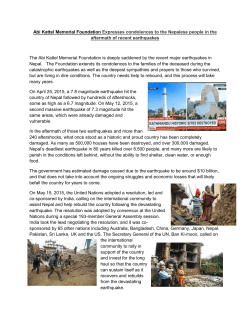
Great Nepal EQ.cdr - Earthquake Engineering Research Centre, IIIT
Earthquake Engineering Research Centre IIIT Hyderabad Technical Lecture on In the Aftermath of The Great Nepal Earthquake... DISASTERS & DEVELOPMENT -Lessons for Safe Building Infrastructure in Telangana & Andhra Pradesh- on 30th April, 2015 (Thursday) at Room no. 105, Himalaya Building, IIIT Hyderabad Speakers Prof. R K Chadha, CSIR-NGRI Prof. R Pradeep Kumar, IIIT Hyderabad Program 4.30-5.00 PM Registration, High Tea 5.00-5.30 PM Glimpse of The Great Nepal Earthquake 5.30-6.15 PM Talk by Prof. R K Chadha 6.15-7.00 PM Talk by Prof. R Pradeep Kumar RSVP: R Pradeep Kumar Professor of Civil Engineering E-mail: eerc@iiit.ac.in Ph: +91 98662 39590 in association with: Indian Concrete Institute AP, Hyderabad Centre Association of Consulting Civil Engineers (India) Indian Association of Structural Engineers About the Lecture: The 7.9 magnitude earthquake that shook Nepal and the northern parts of the country on April 25, 2015 should come as a wake-up call to all the stake holders in building sector in the country. According to current seismic zone map of India around 60% of the land area in the country is prone to moderate to severe earthquakes. It is observed that every time an earthquake occurs, major losses in terms of human lives and property are due to collapse of improperly designed & constructed buildings/important structures. The Indian construction industry has seen manifold increase in its growth due to rapid urbanization in the recent past. This has led to unwanted urgency in construction activities resulting in haphazard mushrooming of new cities and townships bordering major cities with scant respect for safety aspects. As most of these constructions are without earthquake resistant measures, the built-in environment becomes vulnerable to damaging earthquakes be it in Seismic zone II, III, IV or most dangerous V. The state of Telangana and Andhra Pradesh are on the threshold of fast track development to improve the lives of people. It becomes very important to be on right track while we collectively participate in these development efforts and see that all precautions are taken to avoid disasters in future. This technical event is necessitated with an aim to focus on scientific and engineering aspects of the earthquake hazard in the state of Telangana and Andhra Pradesh, in particular and the entire country in general. An attempt will be made to have a road map to move forward to reduce earthquake risk in our states and also in the country. About the Speaker: Dr.R K Chadha obtained his Masters in Geology from Osmania University and Ph.D in Applied Geophysics from the Indian School of Mines, Dhanbad. Dr.Chadha is presently the Chief Scientist (Seismology) at the National Geophysical Research Institute, Hyderabad, India. Dr.Chadha’s initiatives in digital broadband seismology, post Latur earthquake in 1993 have provided high fidelity data to understand the Indian shield seismicity and structure of the Indian lithosphere. Dr.R.K.Chadha is presently the Secretary General of the Asian Seismological Commission under IASPEI (an IUGG association). Dr.Chadha is a Fellow of the National Academy of Sciences, India, APAS, IGU and IGC. Dr. Chadha’s present interest is in the field of seismic hazard estimation in the Indo-Gangetic plains using strong motion records. R. Pradeep Kumar holds a PhD degree in earthquake engineering from University of Tokyo, Japan. He is presently Professor of Civil Engineering and Head of Earthquake Engineering Research Centre (EERC) at IIIT Hyderabad. His research interests are numerical modeling of faults and tectonic plates, collapse simulation of buildings, seismic evaluation and strengthening of buildings and concrete codes in India. He is a member of the Earthquake Engineering Committee, CED 39, Concrete Committee, CED 2: IS 456 & IS 1343 of the Bureau of Indian Standards. About EERC: Earthquake problems are not new to our country. Several earthquakes in the last two decades caused enormous loss of life and damage to property. These events are ravaging nations leaving behind countless victims. Pre-disaster planning i.e., mitigation and preparedness can have a good impact on minimizing the post-disaster response i.e., emergency, rescue and rehabilitation. This also reduces tragedy and suffering to a great extent. One main reason for the casualties is collapse of buildings. The EERC at IIIT-H was established to address this issue, in addition to reducing damage to property during earthquakes. Major research areas of focus include 1) Seismo-tectonic modeling of Indian plate, 2) Fault motion analysis & wave propagation, 3) Site amplification & microzonation studies, 4) Nonlinear behavior of structures, 5) Seismic assessment of buildings & heritage structures and 6) Post earthquake studies. In addition to these, EERC has been working towards earthquake awareness and preparedness of schools and communities, and capacity building of technical personnel in government and private organizations. This is done through lectures for administrators and school children, short-term courses for practicing architects, engineers and faculty members on regular basis.
© Copyright 2025











